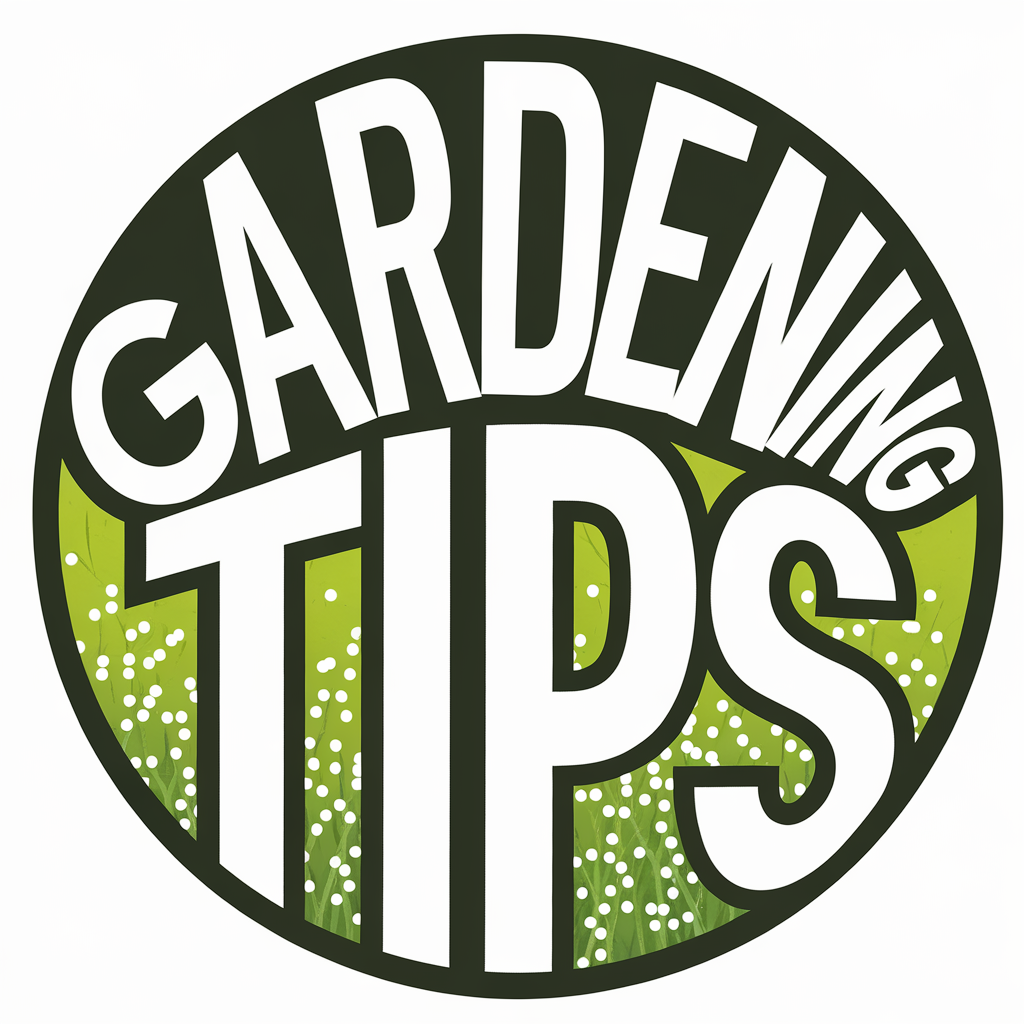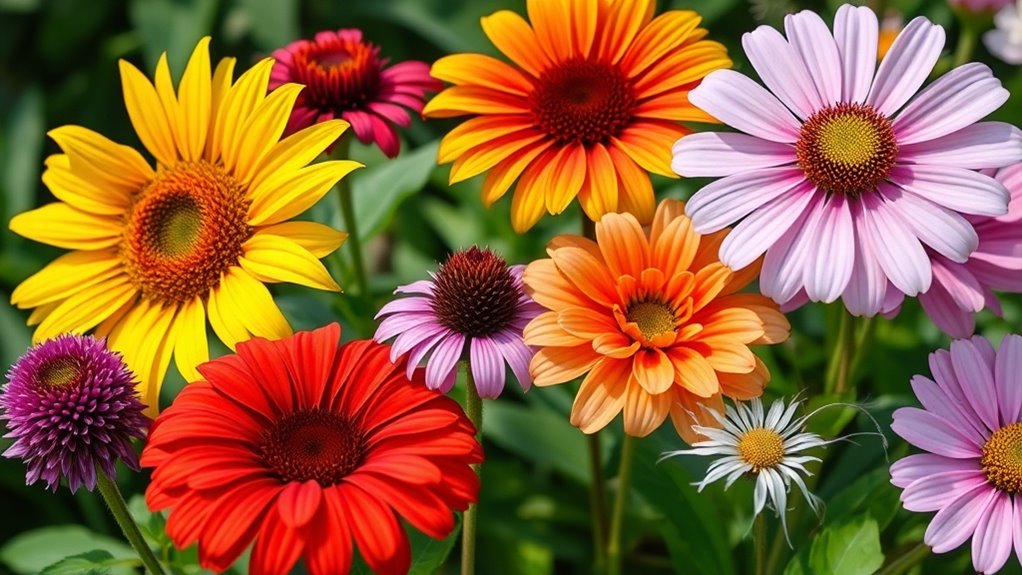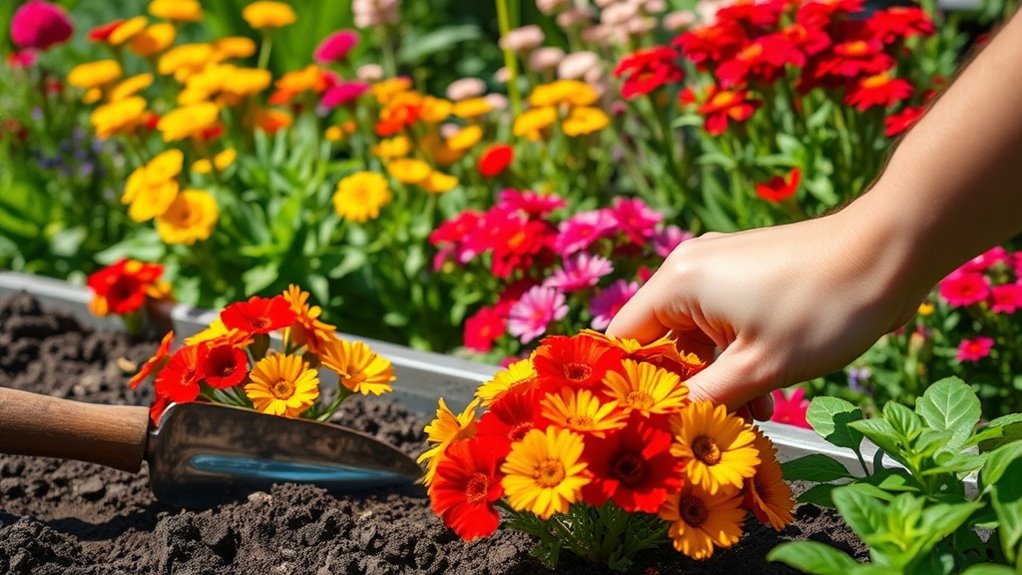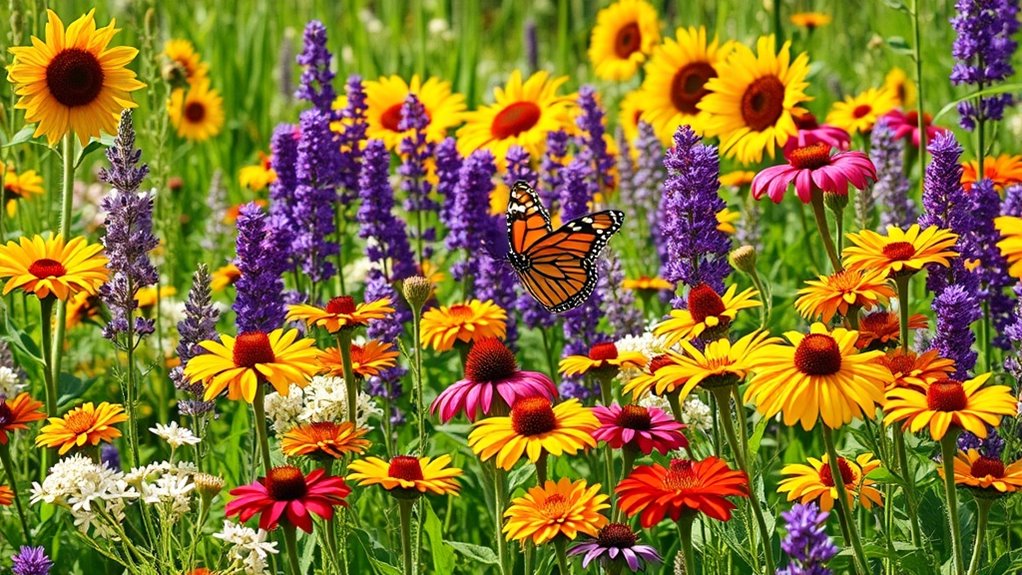8 Flowers That Attract Pollinators Like Crazy
To attract pollinators like bees, butterflies, and hummingbirds, consider planting bee balm, black-eyed Susan, lavender, coneflower, zinnia, marigold, salvia, and aster. These flowers boast vibrant colors and nectar-rich blooms, drawing in beneficial insects to support your garden’s ecosystem. They thrive under various conditions and often require minimal care, making them perfect for boosting biodiversity. Want to discover how to enhance their growth and maintenance? There’s plenty more to explore about these amazing plants.
Bee Balm
Bee balm, known scientifically as Monarda, is a vibrant addition to any garden, particularly if you’re looking to attract pollinators.
This perennial herb features tubular flowers in shades of red, pink, and purple, drawing in bees, butterflies, and hummingbirds.
When flower gardening, consider planting bee balm in well-drained soil and full sun for ideal growth.
Its fragrant foliage also repels certain pests, making it a dual-purpose plant.
Regular deadheading encourages prolonged blooming, enhancing your garden’s appeal.
With its diverse uses and pollinator-friendly traits, bee balm can transform your flower gardening experience into a lively and colorful ecosystem. Additionally, incorporating butterfly-friendly environments by planting bee balm can significantly increase the number of butterflies in your garden.
Black-eyed Susan
After exploring the vibrant allure of bee balm, it’s time to examine another stunning addition to your pollinator-friendly garden: the black-eyed Susan.
This perennial, with its striking golden-yellow petals and dark brown centers, thrives in full sun and well-drained soil.
Its nectar-rich blooms attract a variety of pollinators, including bees and butterflies, making it an essential component of any ecosystem.
By planting black-eyed Susans, you not only enhance the beauty of your garden but also support biodiversity.
They’re drought-tolerant and low-maintenance, ensuring you’ll enjoy their cheerful presence for seasons to come, all while helping our essential pollinator populations. Additionally, these flowers are known for being low-maintenance flowers, which makes them a favorite among busy gardeners seeking effortless blooms.
Lavender
Lavender, with its enchanting fragrance and delicate purple spikes, is a must-have for any pollinator-friendly garden.
This herbaceous perennial attracts bees, butterflies, and hummingbirds, drawn in by its rich nectar and vibrant color.
The essential oils in lavender not only provide a soothing scent but also serve as a natural insect repellent, promoting a healthy garden ecosystem.
Planting lavender in well-drained soil and full sunlight encourages robust growth and flowering.
Its long blooming season offers a continuous food source for pollinators, making it a valuable addition to your landscape.
Additionally, lavender is known for its resilience in poor soil conditions, allowing it to flourish in diverse environments.
You’ll enjoy the beauty while supporting essential pollinator populations.
Coneflower
Coneflowers, or Echinacea, aren’t just visually striking; they’re also incredibly beneficial for pollinators. Their vibrant petals and sturdy structure provide both nectar and pollen, attracting a variety of bees and butterflies. To maximize their growth, make sure you plant them in well-drained soil under full sun, creating an ideal habitat for these important insects. Additionally, incorporating year-round blooms in your garden will ensure that pollinators have a consistent food source throughout the seasons.
Pollinator-Friendly Characteristics
A vibrant splash of color in any garden, coneflowers are renowned for their pollinator-friendly characteristics.
Their large, daisy-like blooms feature prominent, cone-shaped centers that provide easy access to nectar and pollen. This makes them irresistible to bees, butterflies, and other beneficial insects.
The bright pink, purple, or white petals create a striking visual contrast, attracting pollinators from afar.
Additionally, coneflowers can produce abundant flowers throughout the growing season, ensuring a continuous food source.
Their sturdy structure allows them to withstand wind and rain, making them a reliable choice for a dynamic, pollinator-friendly landscape.
You’ll love the activity they bring!
Ideal Growing Conditions
To thrive, coneflowers prefer well-drained soil and full sunlight, ideally receiving at least six hours of direct light each day. They flourish in a range of soil types, from sandy to clay, but do best in fertile, loamy conditions.
Make sure the soil pH is slightly acidic to neutral, around 6.0 to 7.0, to optimize nutrient absorption.
Water coneflowers regularly, especially during dry spells, but avoid overwatering to prevent root rot.
These resilient plants are drought-tolerant once established, making them a low-maintenance choice for gardens.
Zinnia
Zinnias are vibrant flowers that not only brighten gardens but also serve as essential resources for pollinators.
Their colorful blooms attract bees, butterflies, and hummingbirds, making them a favorite among gardeners aiming to support biodiversity.
Consider the following benefits of zinnias for your garden:
- Diverse Colors: Available in shades of red, orange, yellow, pink, and white.
- Long Blooming Period: Flowers from late spring until the first frost.
- Low Maintenance: Require minimal care and thrive in various conditions.
- Cut Flowers: Ideal for bouquets, encouraging pollinator visits.
- Resilient: Tolerate drought and poor soil, ensuring robust growth.
Additionally, incorporating zinnias into your flower bed design can enhance the overall aesthetic appeal of your garden, making it more inviting for both pollinators and visitors.
Marigold
Marigolds are vibrant, hardy flowers that play an essential role in attracting pollinators to your garden. Their bright yellow and orange hues draw in bees and butterflies, enhancing biodiversity. These flowers produce a sweet fragrance and nectar that beckons pollinators, while their open blooms provide easy access. Marigolds are particularly beneficial because they release compounds that repel pests, helping to protect other plants. You’ll find them thriving in various soil types and weather conditions, making them an excellent choice for novice and experienced gardeners alike. Additionally, planting marigolds alongside companion plants like tomatoes can further enhance growth and pest resistance in your garden.
Salvia
Salvia is an excellent choice for attracting pollinators, thanks to its vibrant flowers and distinctive tubular shape, which cater to hummingbirds and various bee species.
To thrive, Salvia prefers well-drained soil and full sun, making it a resilient addition to your garden. Additionally, companion planting with Salvia can enhance the overall health of your garden by promoting beneficial insect activity.
Pollinator Attraction Features
A vibrant array of colors and unique floral structures make Salvia a favorite among pollinators.
These plants exhibit several features that enhance their attraction:
- Color Variety: Bright hues, especially blues and purples, draw in bees and butterflies.
- Nectar Production: Abundant nectar encourages frequent visits from pollinators.
- Flower Shape: Tubular flowers are ideal for hummingbirds and long-tongued insects.
- Fragrance: Pleasant scents signal food sources, attracting diverse pollinators.
- Prolonged Blooming: Extended flowering periods provide consistent resources throughout the season.
Best Growing Conditions
To achieve ideal growth, Salvia thrives in well-draining soil that’s rich in organic matter. This flowering plant prefers full sun, so choose a location with at least six hours of direct sunlight daily. Make sure the soil pH ranges from 6.0 to 7.0 for best nutrient uptake.
Water your Salvia regularly but allow the soil to dry between waterings to prevent root rot. Mulching helps retain moisture while suppressing weeds.
Additionally, consider spacing your plants adequately to enhance air circulation, reducing the risk of fungal diseases. With these conditions, your Salvia will flourish, attracting pollinators to your garden.
Aster
Asters are vibrant, perennial flowers that play an essential role in attracting pollinators, particularly bees and butterflies.
These flowers bloom in late summer to fall, providing essential food sources as other plants fade.
By planting asters, you can enhance your garden’s ecological health.
Here are some key benefits of asters:
- Diverse species that adapt to various climates.
- Long blooming period, ensuring a steady nectar supply.
- Attractive colors that draw in various pollinators.
- Low maintenance, suitable for beginners.
- Supports biodiversity by providing habitats for beneficial insects.
Incorporating asters into your garden can greatly boost pollinator activity.





